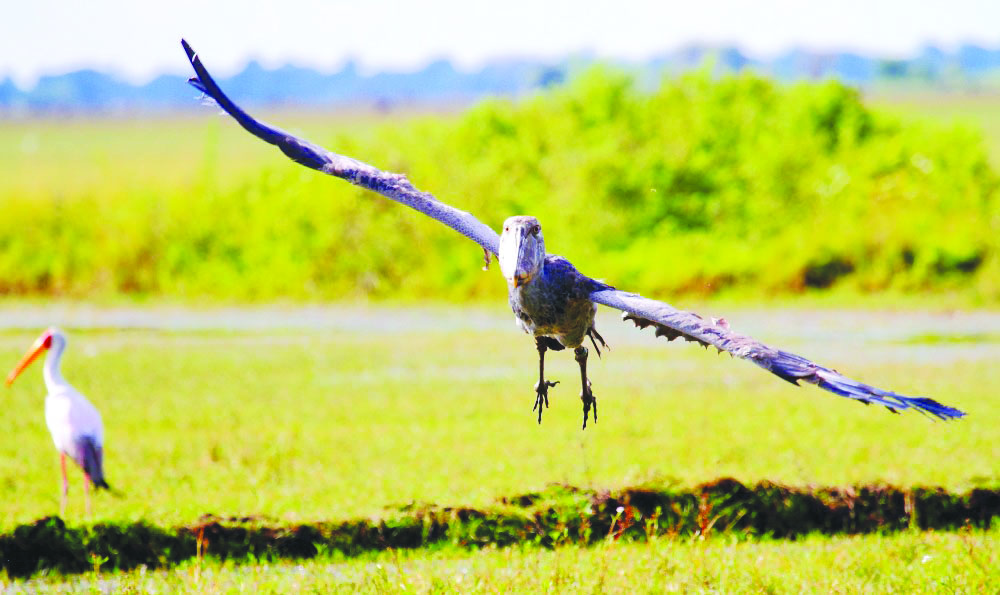. Community unites in conservation efforts for unique bird
MARGARET CHISANGA
Lavushimanda
IT IS still dark when we leave the comfortable lodging at Nkondo for an hour’s drive to Chikuni in the Bangweulu wetlands, in Lavushimanda, Northern Province.
We arrive just as the first rays of the sun hit the waters.
Our host, Maggie Hirschauer, who is the Shoebill programme manager for Bangweulu Wetlands, leads us to our paddlers, Royd Mwanza and Mumba Mwela, who usher us into a dugout canoe.
A little push and we are out in the still waters, our skilled paddlers weaving the boat through narrow pathways set between high reeds. Our goal is to spot the Shoebill in its natural setting, on the floating grass, where it patiently waits to scoop on unsuspecting bubble fish coming up for air.
The Shoebill stork is a fascinating bird, with a prehistoric appearance and a large distinctive beak that can grow up to 24cm in length and 9cm in width. It feeds mainly on fish, thus making the wetlands its natural habitat.
“The most distinguishing feature about this bird is its hock. It has a very sharp hock which it uses to catch and hock the fish. The shape of this is like the shoe, thus the name Shoebill,” Mr Mwanza says.
The Bangweulu Wetlands is made up of seasonal floodplains and swamplands dominated by extensive stands of papyrus, floating grasses and reeds, all creating a lush 6,000km2 wetland landscape.
The whole scene is picturesque, with the boat slowly cutting routes through the floating grass, beautiful water lilies popping purple and yellow colours as the birds chipper off, creating patterns in the sky.
As we cruise through this marshlands, which provides a home to over 430 bird species and 83 fish species, it becomes increasingly clear that the Shoebill is not an easy bird to spot.
“We saw it yesterday up north,” members of a fishing family camped in the wetlands share information.
The community members are part of the Shoebill Nest Protection and Conservation Programme and are constantly on the lookout for the bird, and any nests that the female may set up.
Back at the base, Ms Hirschauer shares more information about the nest protection programme for this quiet and mystery bird.
“This is actually a main pillar of what we do. Our whole captive rearing would not happen without the aspect of community engagement. The amount of people involved in this are many at community level, right from the traditional leadership to the young boys in the fishing community who will tell you where they last spotted a Shoebill,” she says.
The community engagement, through the Captive Rearing Programme, involves notifying the office when eggs are spotted, and being engaged to protect that area until the eggs hatch.
The conservation efforts are designed to preserve and grow the population of the endangered Shoebill.
Research indicates that there are no more than 8,000 birds left in the wild, with their numbers under continuous decline due to their slow breeding habits exacerbated by the illegal pet trade which targets their eggs and chicks, as well as hunting, nest disturbance and overall habitat loss.
“With the growing pressure on the specie’s survival, we realised that we needed to have a carefully thought-out and innovative approach saving it,” Ms Hirschauer said.
After assuming management of Bangweulu’s community-owned protected area in 2008, African Parks developed the Shoebill Nest Protection Programme in 2012, to ensure the protection of Bangweulu’s threatened shoebills.
“Through this programme, community members are employed as guardians to protect the Bangweulu shoebills on a 24-hour basis during peak nesting season between June and
November,” she says.
Following the initiation of the nest protection programme, African Parks, in partnership with Zambia’s Department of National Parks and Wildlife (DNPW), drafted a comprehensive Shoebill management plan to prioritise the conservation of this species.
Highlighted in this Management Plan was a facility designed to rear chicks in captivity to increase breeding success in the Game Management Areas. Eight years later, the concept was finally realised.
In May 2022, the Shoebill Captive Rearing and Rehabilitation Facility was established in the heart of Bangweulu Wetlands in collaboration with African Wildlife Conservation Foundation and Ashia Cheetah Conservation.
Over the years, the Shoebill Captive Rearing and Rehabilitation Facility is already showing its value in conserving another of Africa’s threatened species.
At the base, seven birds are available, with each bird having access to its own pond, and the enclosure kept as silent as possible from human noise and intervention to ensure that they are as much as possible in their natural habitat.
At feeding time, we tag along to the enclosure, ensuring to be as quiet as possible. The fish is passed through the passageway straight into the pond inside the enclosure.
Through the peephole, I watch as one particular Shoebill, standing about a metre tall on think dark legs, bends down as it notices the fish in the pond.
With its beak, it scoops up onefish and gulps it down in one swift move. Then slowly it raises its eyes and stares towards my direction with exotic pale blue
eyes that seem to penetrate right through the walls.
And just as slowly, it turns back towards the pond while making a sound called the ‘Bill clap’ common during feeding
time. It is from this sound that the Shoebill gets its local name ‘mapumambao’ or ‘Ipumambao’ meaning ‘the one who drums on wood’.
In the afternoons, on the drive back to Nkondo, through the village, that stare from the blue eyes stays with me, a reminder that thousands more tourists would love to see this mystery bird, thus all the more reason why it should be protected.


